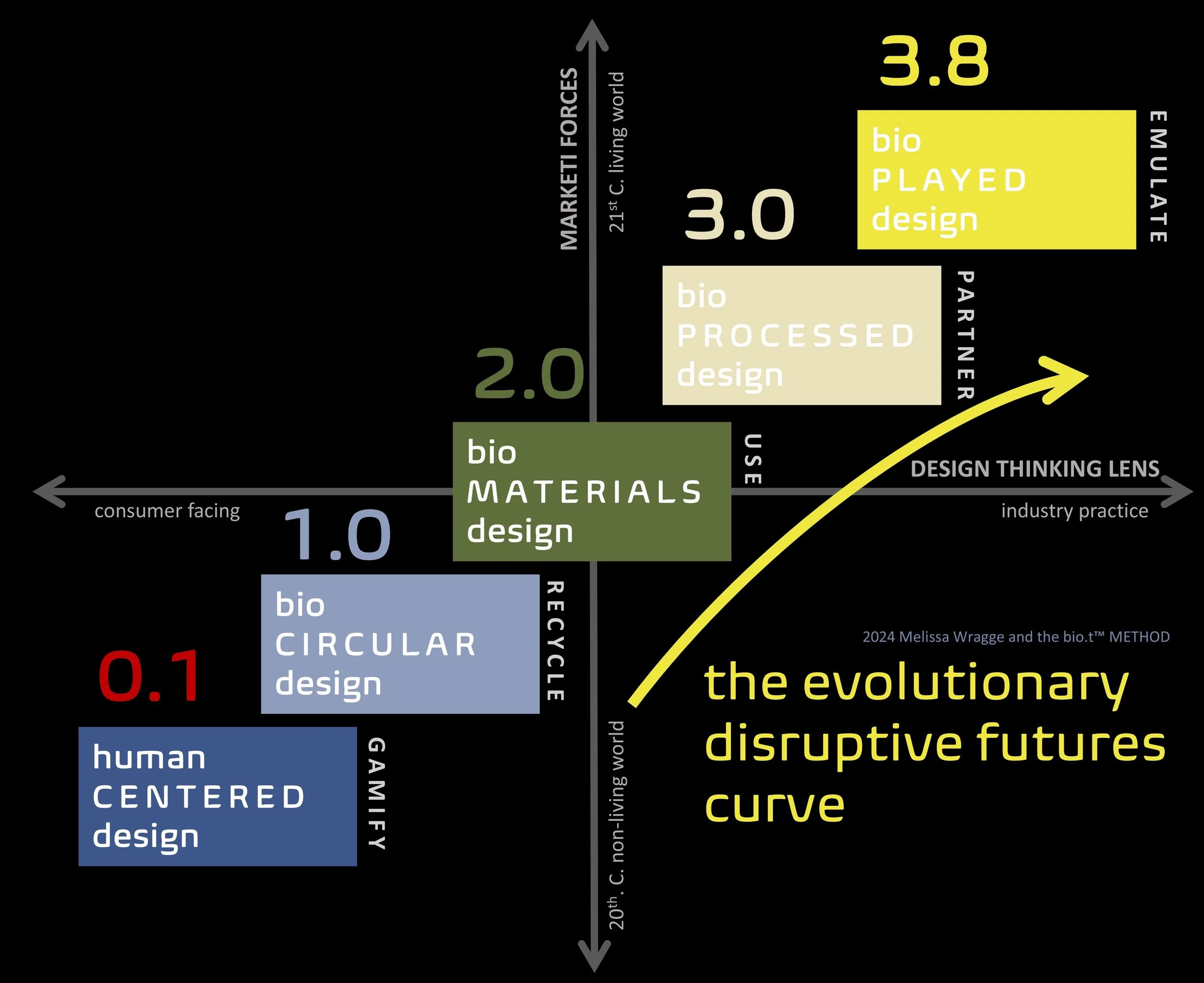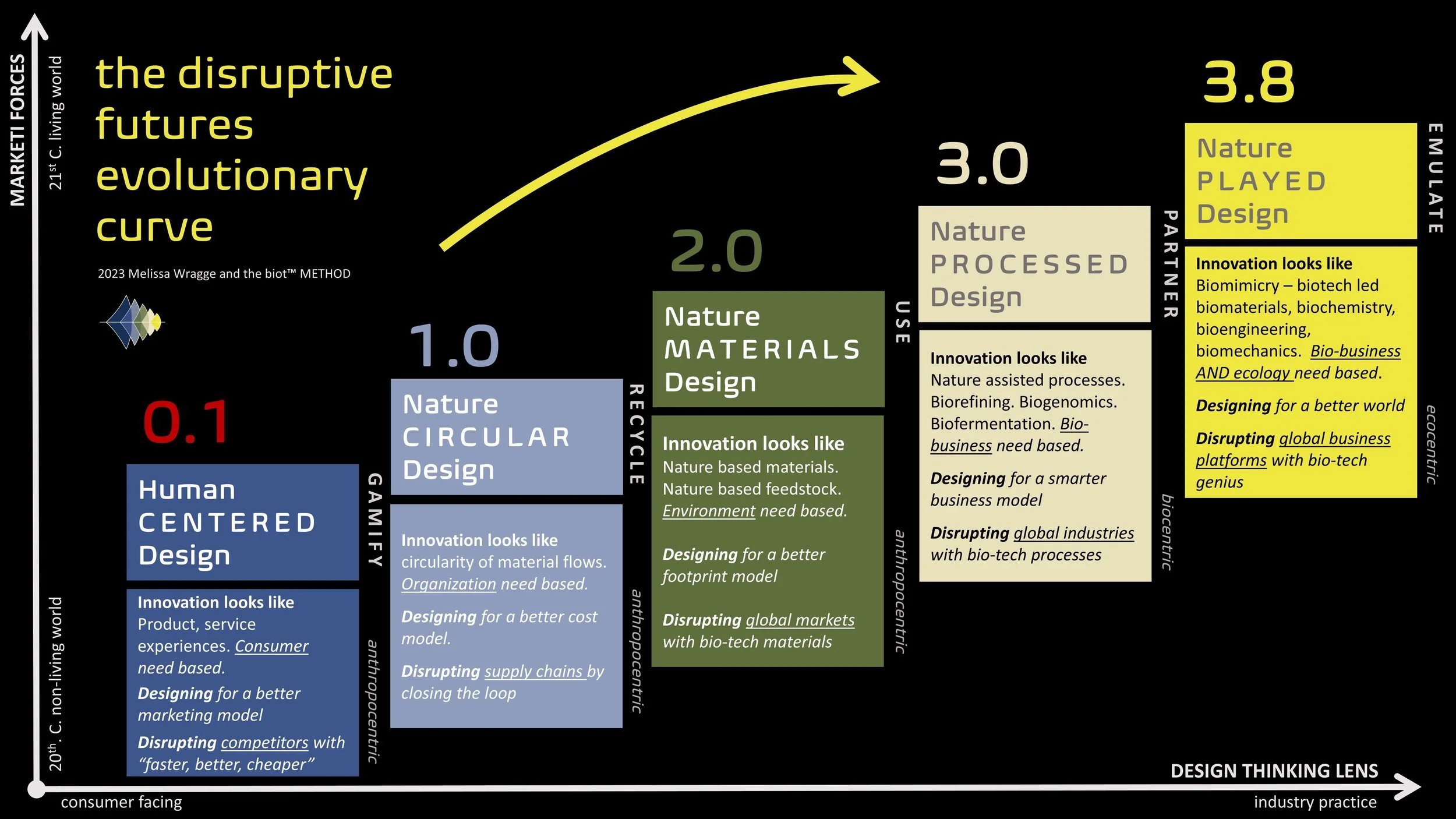
the pathway forward
A Nature Positive game doesn’t just mean governance reporting or bolt-on biodiversity projects. It means a different strategy and innovation game.
if you want to disrupt yourself before others do, there’s a clear pathway to level up.
-
Yes.
You might not be making goods to sell, but you influence flow - the flow of energy, materials, information or money.
Behind every tech solution is a reliance on Nature - with huge opportunity to be radically re/designed.
Nature also has deep functioning design principles that can help you transform yourself - to improve the effectiveness, efficiency or scalability in how your business runs.
DISRUPTIVE DESIGN 0.1
human CENTERED design
This is the baseline. Most of us are taught to play here. This is the game where human centered design has been reduced to consumer centered design, product-market fit and being “faster, cheaper, cheaper”.
Our enemy is the competition. Our weapons of choice are disruptive digi-tech. Our battle strategy is agile, and we pivot and pirouette with this year’s bright and shiny, digi-tech toy. We obsess over customer experience pain-points and cybersecurity. Our currency of value is binary bits.
The solution to everything orbits around large language tools, and we gamify and offset all the annoying Life bits.
Let’s call this the Gamify Nature Game.
Designing for a better customer experience. Disrupting the competition. Our lens on Life is risk reporting, compliance, and a sprinkle of fairy dust for brand management. The net result is material and energy entropy.
DISRUPTIVE DESIGN 1.0
bio CIRCULAR design
This is the game of circular design, and some awesome businesses are playing here. Our enemy is still the competition, but we might be forming a few cooperative relationships with other market players.
It can feel like a big step up. As the father of lean, James Womak said, “it’s hard for most managers to even see the flow of value and, therefore, to grasp the value of flow”.
It requires a SYSTEMS lens. But those of us playing ‘cradle-to-cradle’ are reaping cost efficiency benefits from plugging gaps in our material flows. And it feels good. Our customers like us a bit more. And our compliance manager is no longer on our back.
Let’s call this the Recycle Nature Game.
Designing for a better supply chain model. Disrupting to “Reduce, Reuse, Recycle”. Our lens on life is cost efficiencies. We innovate for material and energy flows.
LEVEL UP | Place-based biomes. Industrial |agricultural symbiosis. Energy and water cycling. EXAMPLES | British Sugar, Kalundborg Denmark symbiosis, Montfort Boystown Fiji symbiosis, Kwinana Australia symbiosis.
DISRUPTIVE DESIGN 2.0
bio MATERIALS design
This is the first Nature-positive game we can play. Global markets are loving businesses who play here. There is no enemy in this game, and the gravitational pull of strategy and innovation is to play at the bleeding edge of biomaterials.
To play this game we need an ECOLOGY lens. To consider other living systems beyond climate - like nutrient flows, water, soil, and biodiversity. And those of us who are investing in the likes of plant cellulose, fungi, chitin are winning. It feels amazing. Our customers now love us. And others are looking to us as leaders.
“I know it sounds crazy, but every time I have made a decision that is best for the planet, I have made money.” - Yvon Chouinard, founder Patagonia
Let’s call this a Nature Materials Game.
Designing for a better Impact model. Disrupting industry material models. Our lens on life is planetary boundaries and wider ecologies. We innovate with biomaterial properties.
LEVEL UP | Selecting for abundant feedstock. Playing as ecosystem architects. EXAMPLES | Ecostore, Allbirds, Ethique, Biohm and Shiru.
DISRUPTIVE DESIGN 3.0
bio PROCESSING design
Now we play the second Nature-positive game. It’s a step up. We focus on how things are made. A few pioneering businesses are playing in this space and global markets are hungrily chasing them.
We overturn archaic high energy, high chemical “heat-beat-treat” manufacturing practices, and start playing in bioprocessing, biorefining and bio-fermentation. While others are obsessing of social media platforms, we’re now building protein platforms. And it feels incredible! People are writing about us. It’s radical redesign.
And here’s the thing. When we bio-refine or bio-ferment, our business model shifts to being place-based, decentralized, and self-organizing. Which massively reduces our supply chain risk exposure, and our energy and material footprint.
We work in partnership with Nature’s organisms, who can do things way better than us. But to do this, we need to honor the rights and ‘personhood’ of our wildlife partners. We need an ETHICS lens. After all, killing off our co-partners (as a ‘resource’), doesn’t make commercial sense. We lean into indigenous wisdom to shift from a Nature-extractive mindset.
Let’s call this a Nature Processed Game
Designing for a better business model. Disrupting industry manufacturing models. Our lens on Life is with respect and agency. We innovate with biological atoms, and partner with bio-organisms.
LEVEL UP | Place-based. Decentralized. Self organizing. Scale up networked models. EXAMPLES | Mint, I-Phyc, String Bio, and Mycocycle.
DISRUPTIVE DESIGN 3.8
bio EMULATED design
Right now, a burgeoning movement is building using a BIOMIMICRY lens. This is what Melissa has been doing her MSc in.
Let’s call this Nature Played Design
Nature’s organisms are no longer dead resources to use, or domesticated assistants in manufacturing. Nature is respected as a powerhouse innovation library of 30m+ species with tried, tested, and proven R&D we can copy for superior product performance, business efficiency and scale. Giving us the blueprints, the hardcoding and the working models. Plug and play.
Biomimicry is the bridging tool to apply Nature’s intelligence to solving how we re/engineer and re/design our products, services, platforms, processes, business models, and organizational practices. We can even apply it to social innovation.
The tech is less digi-tech, it’s more biotech. The innovation is built not off binary bits, but biological atoms. It’s unpacking and applying the biology, chemistry and physics genius of Nature.
You don’t have to be a scientist. You just need to learn the deep patterns of how Nature designs. This is the game any business, from anywhere, can play.
“Work with life centered principles & the universe pitches in to help.” - Buckminster Fuller
The advantage is we not only play at the highest level of sustainability, we unlock the door to the biggest disruption game there is. It’s truly pioneering. And it feels abundant - because it is. Like hope in a bowl for breakfast. Like how life was designed to work.
Designing for better futures. Disrupting global business models. Our lens on Life is deference and learning. We innovate by emulating Nature’s genius, hidden in plain sight.
EXAMPLES | Encycle SwarmLogic, Biome Renewables, Humble Bee Bio, Seprify, Nanomik Bio-tech and Strong by Form.
let’s play that back
from human-centered design to life-centered design
why does this matter?
Because as global markets price in the materiality of the living world, the game rules for business disruption are overturning. If you’re sitting on a 20th century business model or mindset, you’re exposed to massive risk. But if you play a Nature-played game there is massive disruptive opportunity.
every step up is amazing.
-
Life centered design does a 180° flip on human-centered design thinking. The lens is more living systems than linear markets. The tech language is more biological atoms than binary bits. And the leverage points are based more off the physical laws of Nature than the laws of game theory.
The more you answer YES to the following, the more likely you are to be holding back your potential - and carrying a ton of risk:
Your approach to INNOVATION is "faster, better, cheaper, newer".
Your approach to STRATEGY is unfair competitive advantage.
Your approach to ADAPTATION is Agile.
Your approach to TRANSFORMATION is digitization (or restructuring lol).
Your conversation about DISRUPTIVE TECH FUTURES is based around large language tools.
Your approach to NATURE POSITIVE is compliance disclosures, biodiversity credits, or TNFD tick boxes.
Your approach to LEVERAGE hinges off extraction, exploitation, data scraping, restricted access, price arbitrage, borrowing, or zero sum plays.
The #1 barrier that stops many people playing the bigger game is the ability to sense, seize, and scale value potential (called “dynamic capabilities”).
In our Age of Biology, value potential is biological. Update your design thinking practice.




